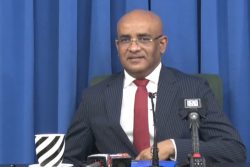Gold-producing countries’ signing on to the Minamata Convention on Mercury, a global treaty aimed at protecting human health and the environment from the adverse effects of mercury, particularly though not exclusively in its use in gold-recovery in the gold-mining industry, may, in some circumstances, be less than effective in pursuit of its objective, according to a recent report published in the US-based science publication, Science Daily.
Notwithstanding the fact that a number of countries, including Guyana, are signatories to the high-profile agreement on mercury use the in mining sector, an article in the Science periodical dated April 23 alludes to “a study of baseline mercury emission estimates reported by 25 countries — many in developing African, South American and Asian nations” asserting that estimates accepted under the Minamata Convention rarely provide enough information to tell whether changes in the rate from one year to the next were the result of actual change or data uncertainty. ”Key variables — like how the country determines the amount of its gold production — can result in vastly different baseline estimates… yet, countries often don’t report this range of possible estimates,” the Journal says. The significance of this revelation raises questions as to whether countries involved in gold-mining may not be ‘sheltering’ under a delusionary protective cloud by assuming that adherence of the tenets of the Minamata Agreement serve to help mitigate mercury poisoning in the gold mining industry.
Guyana signed and ratified the Minamata Convention on Mercury in October, 2013 and in September, 2014, respectively. The Minamata Convention is an international treaty designed to protect human health and the environment from anthropogenic emissions and releases of mercury and its compounds and continues to assert a commitment to the Convention, notwithstanding the surfeit of irregularities that are known to obtain in the remote gold-mining regions of the country. The Minamata Treaty notwithstanding, “mercury emission estimates rarely provide enough data to assess success in eliminating harmful global gold mining practice,” the Science Daily says. The Science Daily article asserts that “about 15 million artisanal and small-scale gold miners around the world risk their lives every day facing hazardous working conditions that include constant exposure to mercury,” the implication here being that the risk could be even higher if the protective bona fides of Minamata are found to be questionable.
The article quotes US Chair of Civil and Environmental Engineering and Solomon Professor for Global Development in SMU’s Lyle School of Engineering, Kathleen Smits, as saying that signatories “providing more transparency in reporting” could help remedy the problem. The challenge for gold mining countries in this regard is that in this high-risk and frequently high-returns sector, mineral-recovery pursuits are underpinned by practices that are frequently either on the edge of or else, completely outside the control of the authorities. Here in Guyana, the resources necessary to curb irregularities in the gold recovery industry (in a sector that is known to be riddled with corruption) are weak and less than reliable, while there is little, if any, publicly available information as to just how the enforcement mechanisms that are necessary for the effective enforcement of Minamata Agreement are applied.
The article refers to a study recently published in the journal Environmental Science and Policy which
analyzed 22 countries’ National Action Plans (NAP) that included their annual baseline estimates assembled under the Minamata Convention and posted on the organization’s website. The team also reportedly looked at three additional countries with pertinent information posted to national government or non-governmental websites. Since Guyana’s first successful oil recovery effort in 2015, both official effort and media attention have shifted markedly from the gold-mining sector where serious operational irregularities, including those that have to do with safety, have long been known to exist. While, in many gold-mining countries the mercury to gold ratio is determined through previous research and field visits to known mining locations, the studies cite weaknesses in this approach, contending that “different data sources can provide vastly different values.”
While the Government of Guyana remains a signatory to the Minamata Treaty, the country’s persistent adherence to the its tenets, including the lock of central government control over gold-mining operations in the remote regions of the country raises a number of valid questions as to how well positioned the country is to provide verifiable information pertaining to whether or not operational practices in the sector comply with the strictures of the Minamata Convention.










